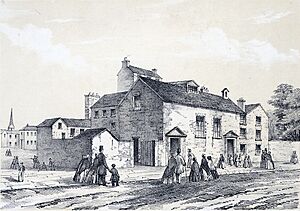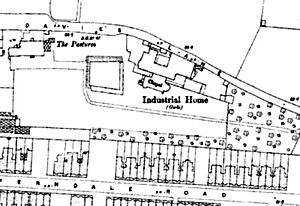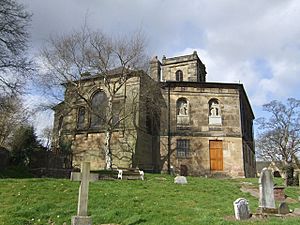Mary Fletcher (preacher) facts for kids
Quick facts for kids Mary Fletcher (preacher) |
|
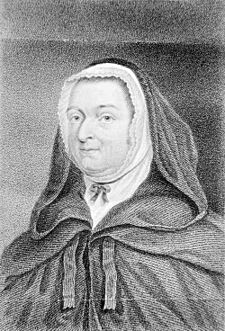 Portrait of Mary Bosanquet Fletcher, created while she preached at Madeley |
|
| Born | 12 September 1739 in Leytonstone, Essex, England |
|---|---|
| Died | 8 December 1815 (aged 76) in Madeley, Shropshire |
| Nationality | British |
| Spouse | |
Mary Bosanquet Fletcher (born Bosanquet; 12 September 1739 – 8 December 1815) was an English preacher. She is famous for convincing John Wesley, who started Methodism, to let women preach in public.
Mary came from a rich family. But after she became a Methodist, she chose a simpler life. She spent her life helping others. She ran a school and an orphanage until she married John Fletcher. Mary and her friend, Sarah Crosby, started preaching and leading meetings at her orphanage. They became the most well-known female preachers of their time. People called Fletcher a "Mother in Israel." This was a special Methodist title for her work in spreading the faith across England.
Mary's Early Life
Mary Bosanquet was born in September 1739 in Leytonstone, Essex. Her parents were Samuel Bosanquet and Mary Dunster. When she was born, her tongue was stuck, and she almost died when it was fixed.
Mary's family were Anglicans with French Huguenot ancestors. Her father was a powerful man in Leytonstone and a top merchant in London. Mary had an older sister and two younger brothers. Her brother Samuel later became a director of the Bank of England. Mary grew up very wealthy, wearing fancy clothes and going on holidays to places like Bath and Scarborough.
Becoming a Methodist
Mary first learned about Methodism when she was about seven years old. A Methodist servant girl in her home talked about religion with Mary and her sister. However, her parents didn't like this and sent the servant away.
When Mary was 13, her father had her confirmed as an Anglican at St Paul's Cathedral. Later, Mary's older sister introduced her to Mrs. Lefevre, a member of the London Foundery Society. This made Mary even more interested in Methodism. She started to dislike her rich lifestyle. By age 16, she refused to go to the theatre or spas. She also began to dress simply.
In 1757, Mary met Sarah Crosby, a Methodist class leader. Meeting Sarah helped Mary fully decide to become a Methodist. She then gave her life to God and helping others. She stopped caring about her wealth and became active in the Foundery Society. She visited Sarah Crosby and Sarah Ryan in Moorfields to learn more.
By 1760, Mary and her family had many disagreements. Mary turned down a marriage proposal from a rich young man. This made her parents angry. She told them she wanted to serve God instead. This, along with her rejection of wealth and her parents' fear that she would make her brothers Methodists, led her family to ask her to leave. She moved into a simple home in Hoxton Square with Sarah Ryan.
Helping Others: Charity Work
The Cedars Orphanage
In 1763, Mary changed her mind about her wealth. She decided to use it for charity. On March 24, 1763, Mary and Sarah Ryan moved to one of Mary's family homes, called The Cedars, in Leytonstone. They felt God wanted them to help others. They wanted to start an orphanage and school like John Wesley's Kingswood School. Sarah Ryan had worked at Kingswood, so she helped Mary set up their school. They hired a maid and took in Sarah Ryan's orphaned niece, Sally Lawrence. As more people came and Sarah Ryan's health got worse, they hired Ann Tripp as a governess. Other Methodist women, like Sarah Crosby and Mary Clark, also joined them.
The women at The Cedars took in poor people from London, including those who had lost their way. The residents wore dark purple cotton uniforms and ate meals together. Children learned manners, reading, religion, writing, nursing, and home skills. This prepared them for their future lives.
Mary was not just the owner of the orphanage. She also managed most of its daily work. She planned and led worship, handled money, taught the children, held weekly children's meetings, supervised Methodist gatherings, and cared for the sick. She invited sick women to The Cedars for treatment. Some stayed after getting better to help Mary.
Mary Bosanquet and Sarah Crosby started nightly Scripture readings and prayers. There was no Methodist group in Leytonstone at the time. To improve the religious life at the orphanage, the women asked John Wesley to send a preacher. Wesley sent Mr. Murlin, who was successful. The orphanage soon became a Methodist society. Mary Fletcher and Sarah Crosby continued their own religious services on Thursday nights. They began to attract large crowds. The Cedars became a main center for Methodism in Leytonstone. Some Methodist men tried to stop Mary and Sarah, but they couldn't.
When Mary and Sarah first moved in, villagers would throw dirt at anyone leaving the house. They would also yell at and spy on the residents. Once, Mary was told that four men planned to break up a Methodist meeting at her home. The men came, and Mary treated them kindly. She led the meeting as usual. At the end, she gave each man Methodist pamphlets. The men reportedly took the pamphlets, bowed to Mary, and left peacefully.
Over five years, the orphanage helped 35 children and 34 adults. Usually, 15 to 20 people, mostly girls, stayed at The Cedars at one time. John Wesley greatly praised the women's work at The Cedars.
Cross Hall Orphanage
In 1768, the school moved to a farm called Cross Hall in Morley, Yorkshire. Mary Fletcher and Sarah Ryan started a new orphanage there and took in 14 girls. They moved from The Cedars to Cross Hall to save money. They planned to grow their own food. They also hoped the new place would be nicer for the children and improve Sarah Ryan's health.
However, these goals were not met. Mary and the other women had little farming experience, so growing their own food was not very successful. Sarah Ryan died soon after they arrived. Mary faced criticism for her work at Cross Hall. Some said her punishments for the children were too strict. Others said she was creating a convent or wasting her time. Her family thought she was wasting her inheritance. Despite these criticisms, Mary continued to run Cross Hall until her marriage. It closed on January 2, 1782. Before closing, Mary made sure all the children found new homes or jobs.
Mary's Friendship with Sarah Ryan
While working at The Cedars, Mary Fletcher and Sarah Ryan became very close. Sarah was like a mother to Mary. John Wesley recognized their strong bond, calling them "twin souls." After Sarah Ryan died in 1768, Mary fell into a depression. Her only comfort was dreaming that Sarah was still alive. Mary's bond with Sarah was so strong that John Fletcher accepted Sarah as part of their partnership when he married Mary.
Preaching and Church Work
While living and working at The Cedars, Mary Fletcher and Sarah Crosby began holding Methodist meetings at night. In the summer of 1771, Mary wrote to John Wesley to defend their work. This work was now continuing at Cross Hall. This letter is seen as the first full defense of women preaching in Methodism. Mary argued that women should be allowed to preach when they felt a special "call" from God. Wesley accepted this idea. He formally began to allow women to preach in Methodism in 1771.
However, some scholars, like Thomas M. Morrow, argue that Wesley only allowed women to preach because they were good at converting people. He might not have truly changed his mind. He saw it as a way to grow his church, not as a statement about women's rights.
In February 1773, Mary Fletcher did something against Wesley's rules for women preachers. She referred to a Bible text in her sermon. Wesley had supported women preaching in public after Mary's letter in 1771. But he was still unsure about women preaching in the same ways as men. However, Wesley seemed impressed by her preaching style and let her continue. She was called "a mother in Israel," a title given in the Bible to the prophetess Deborah.
Even though Mary was brave and defended her preaching, she wasn't always confident. In her diary and letters, she often wrote about feeling nervous about leading worship. Mary could only continue her work because her friends and fellow preachers supported her. Her preaching attracted many people. In September 1776, she spoke to a crowd of 2,000 in Golcar. Several times, her friends encouraged her to become a traveling preacher because of her success. But she preferred to focus on her local community.
Marriage and Ministry
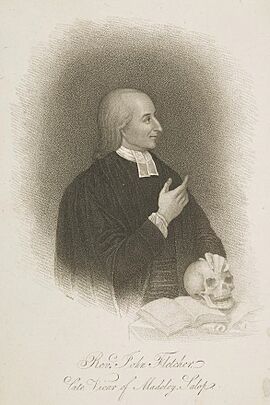
John Fletcher and Mary Bosanquet first met in 1756 or 1757 at The Foundery. John Fletcher was a Swiss-born clergyman who helped John Wesley. At that time, he thought about asking Mary to marry him. But he decided against it, believing she was too rich to accept him. He also thought it would be better if he gave his life fully to God.
In June 1781, Mary received a letter from John Fletcher. He told her he admired her and had since they first met. They married at Batley Church in Yorkshire on November 12, 1781.
Mary and John moved to Madeley, Shropshire, on January 2, 1782. They started a joint ministry there. They were seen as the first "clergy couple" among the Methodists. People in Madeley were very impressed by their preaching. Earlier attempts to convert and preach to the residents had not worked. Mary not only preached, but she also nursed the sick, met with Methodist classes, and held Methodist meetings. She and John worked together to run a school in Madeley, teaching religion, reading, and writing. Their marriage was short, however, as John Fletcher died on August 14, 1785.
Later Life and Continued Work
In 1785, John Wesley tried to convince Mary Fletcher to leave Madeley. He wanted her to work with the Methodists in London. She refused, believing she was meant to continue her late husband's work in the parish. Mary kept some control over the local church. Her husband's replacement let her advise him on who should be a curate. She was also allowed to live in the vicarage for the rest of her life.
She continued to preach at Madeley and started preaching in nearby villages like Coalbrookdale and Coalport. She also continued to lead Methodist classes for children and adults.
Around 1799 or 1800, Mary Tooth moved in with Mary Fletcher. Mary Fletcher began training Tooth to take over her work. In 1803, the Methodist Conference decided they no longer supported women preaching. Leading preacher Mary Taft, who had caused some debate, didn't pay much attention. The Tafts stayed with Mary Fletcher for a week in 1810. They would have met Mary Tooth, who said she hadn't been apart from her "beloved" Mary Fletcher for more than 24 hours in 15 years. Mary Tooth took on some duties, but Mary Fletcher continued her work within the Wesleyan Methodist Connexion until shortly before she died. It was reported that in 1814, at age 75, she still preached five times a week. Her last sermon was on July 25, 1815. Three months before her death, she also stopped leading religious meetings and classes.
Mary's Death
Mary Fletcher died on December 9, 1815. She was buried at St Michael's Church, Madeley, in the same grave as her husband. In her last days, her friend and successor, Mary Tooth, cared for her.
Mary Fletcher's Legacy
The Fletcher family held an important position at the church in Madeley for three generations. Records show that the churches in Madeley were more popular than those in nearby areas even as late as 1851. This was 36 years after Mary Fletcher's death.
Mary Fletcher's life story was reprinted many times in the 50 years after she died. Mary Tooth also wrote a Letter to the inhabitants of Madeley on the death of Mary Fletcher in 1825. She continued Mary Fletcher's work. Mary Fletcher's converts now had children and grandchildren, and Mary Tooth became their spiritual guide. In May 1816, Mary Tooth moved into a new home near the vicarage. In an upper room, she created a public meeting place. She had the communion table from the church and a clock from Mary Fletcher's old home. Madeley became a place for modern pilgrims to visit.
In 1895, Agnes Cotton opened a home for girls in Leytonstone. Cotton bought what used to be The Cedars. She renamed the house The Pastures. Later, she opened a larger home on the same site.
Mary's Writings
Mary Fletcher published several religious pamphlets during her life. These were mostly for women. For example, Jesus, Altogether Lovely (1766) told single women to stay true to Jesus. An Aunt's Advice to a Niece (1780) gave more religious instructions for baptism and confirmation. Thoughts on Communion with Happy Spirits (1785) talked about her husband's death. She wondered if he was still with her in a spiritual way.
Mary Fletcher also published some of her letters in the Methodist Arminian Magazine. Although she didn't write it herself, she copied and saved The Vision. This was an account of a religious dream. A copy of one of Mary Fletcher's sermons was found recently. Dated June 8, 1794, the sermon was given in the vicarage at Madeley. It talks about being faithful and loving towards God.
Mary Tooth gave her autobiography to the Methodist writer Henry Moore. Moore combined her autobiography with her letters and diary entries. He published them as a book called The Life of Mrs. Mary Fletcher.


